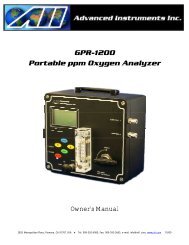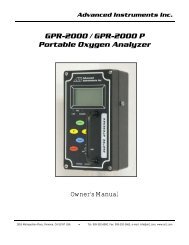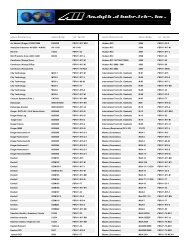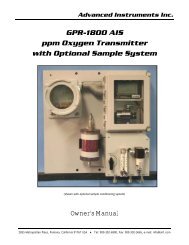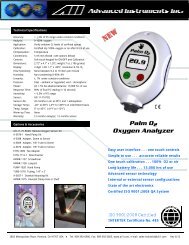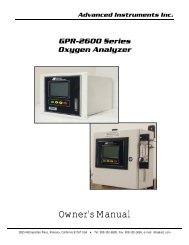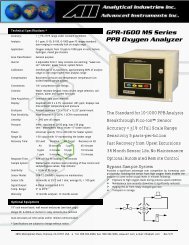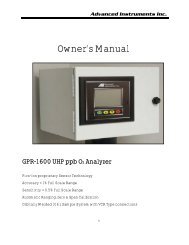GPR-18 MS ATEX Explosion Proof PPB Oxygen Analyzer.
GPR-18 MS ATEX Explosion Proof PPB Oxygen Analyzer.
GPR-18 MS ATEX Explosion Proof PPB Oxygen Analyzer.
- No tags were found...
You also want an ePaper? Increase the reach of your titles
YUMPU automatically turns print PDFs into web optimized ePapers that Google loves.
Advanced Instruments Inc.Accuracy & CalibrationSingle Point Calibration: As previously described the galvanic oxygen sensor generates an electrical current proportional tothe oxygen concentration in the sample gas.Absolute Zero: In the absence of oxygen the sensorexhibits an absolute zero, e.g. the sensor does notgenerate a current output in the absence of oxygen.Given these linearity and absolute zero properties, singlepoint calibration is possible.Pressure: Because sensors are sensitive to the partialpressure of oxygen in the sample gas their output is afunction of the number of molecules of oxygen 'per unitvolume'. Readouts in percent are permissible only whenthe total pressure of the sample gas being analyzedremains constant. The pressure of the sample gas andthat of the calibration gas(es) must be the same (reality< 1-2 psi).Temperature: The rate oxygen molecules diffuse intothe sensor is controlled by a Teflon membrane otherwiseknown as an 'oxygen diffusion limiting barrier' and all diffusion processes are temperature sensitive, the fact the sensor'selectrical output will vary with temperature is normal. This variation is relatively constant 2.5% per ºC.A temperature compensation circuit employing a thermistor offsets this effect with an accuracy of better than +5% (over theentire Operating Range of the analyzer) and generates an output function that is independent of temperature. There is no errorif the calibration and sampling are performed at the same temperature or if the measurement is made immediately aftercalibration. Lastly, small temperature variations of 10-15º produce < 1% error.Accuracy: In light of the above parameters, the overall accuracy of an analyzer is affected by two types of errors: 1) thoseproducing 'percent of reading errors', illustrated by Graph A below, such as +5% temperature compensation circuit, tolerancesof range resistors and the 'play' in the potentiometer used to make span adjustments and 2) those producing 'percent of fullscale errors', illustrated by Graph B, such as +1-2% linearity errors in readout devices, which are really minimal due to today'stechnology and the fact that other errors are 'spanned out' during calibration. Graph C illustrates these 'worse case'specifications that are typically used to develop an transmitter's overall accuracy statement of < 1% of full scale at constanttemperature or < 5% over the operating temperature range. QC testing is typically < 0.5% prior to shipment.Example: As illustrated by Graph A any error, play in the multi-turn span pot or the temperature compensation circuit, duringa span adjustment at 20.9% (air) of full scale range would be multiplied by a factor of 4.78 (100/20.9) if used formeasurements of 95-100% oxygen concentrations. Conversely, an error during a span adjustment at 100% of full scale range isreduced proportionately for measurements of lower oxygen concentrations.Refer to the Calibration section for additional information.14



